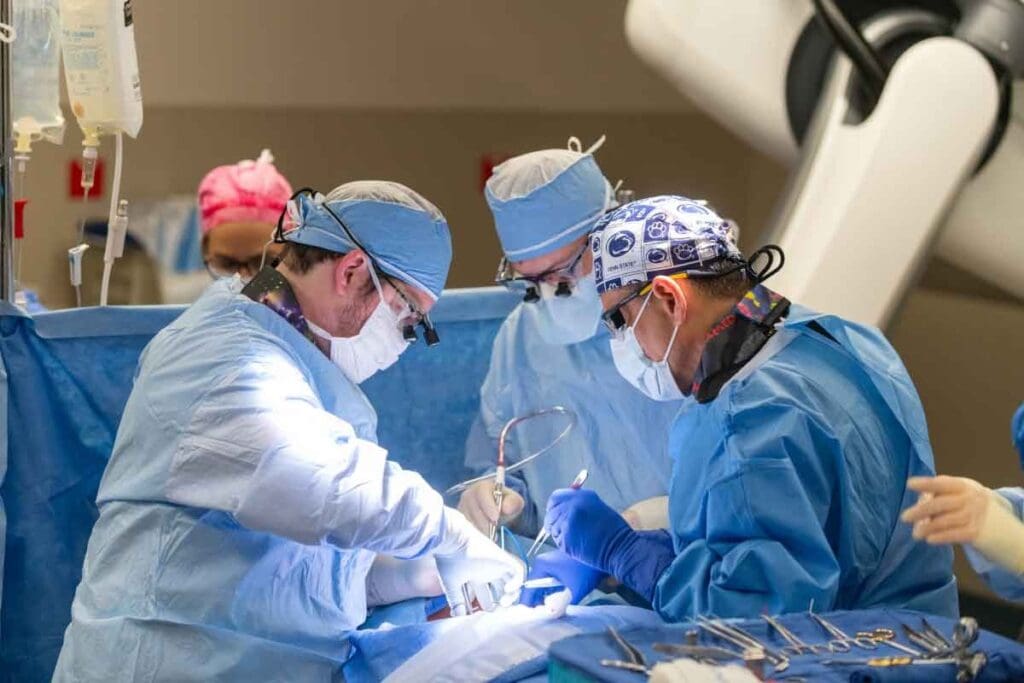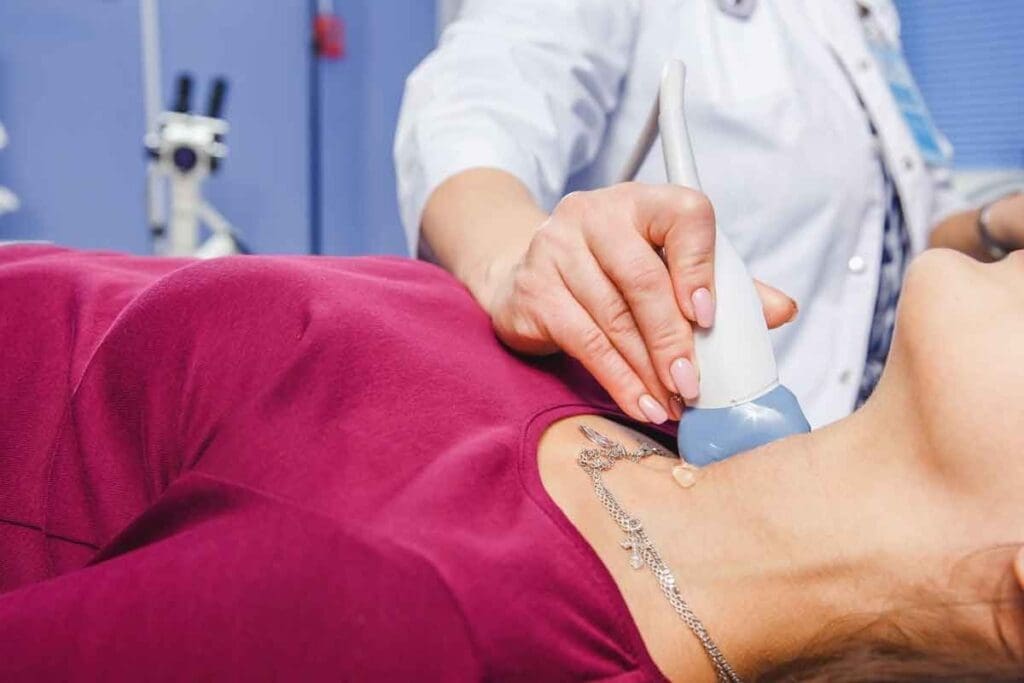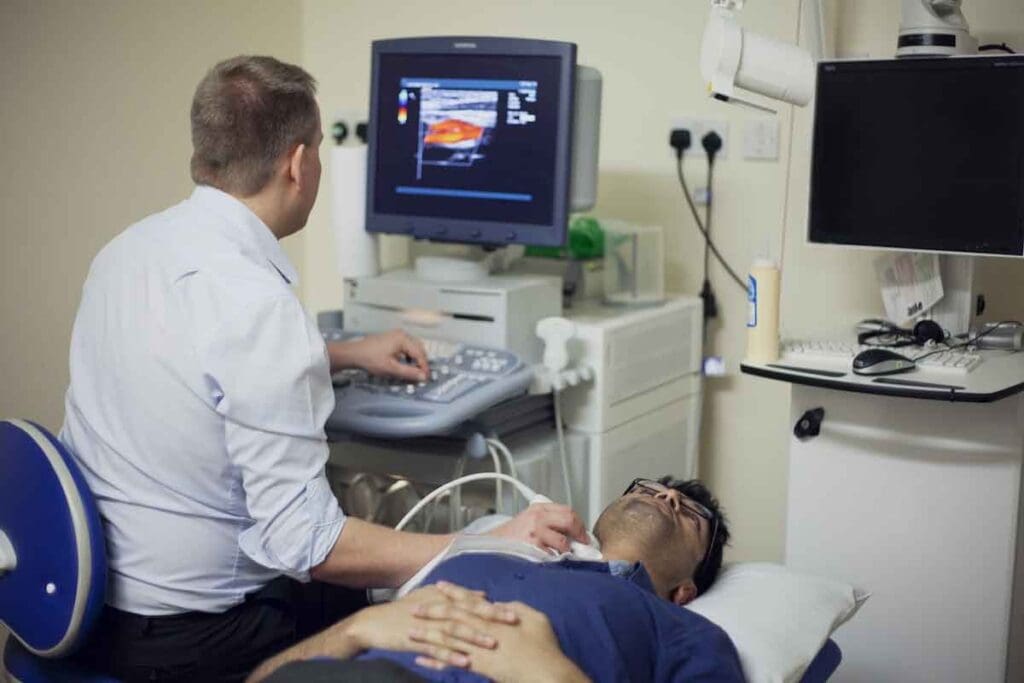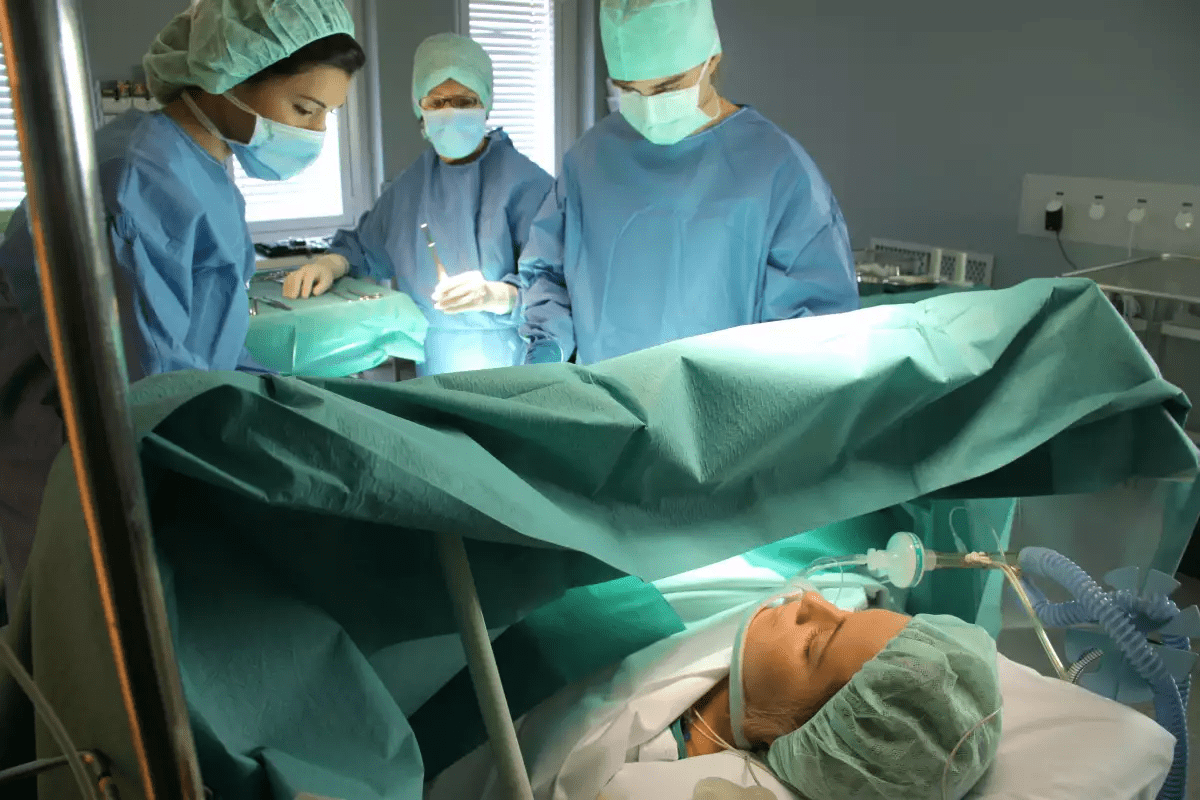Last Updated on November 26, 2025 by Bilal Hasdemir

Knowing about the carotid artery angiogram is key for those facing this test. At Liv Hospital, we help you understand what’s coming. We make sure you’re ready and feel at ease every step of the way.
The carotid arteries are essential for carrying blood from the heart to the brain. A carotid angiogram is a non-invasive test to check these arteries for any issues.
We employ cutting-edge technology, like the latest CT angiogram carotid artery tools. This helps us spot even the smallest problems and plan life-saving treatments.
Key Takeaways
- Understand the purpose and benefits of a carotid artery angiogram.
- Learn how to prepare for the procedure.
- Discover what to expect during and after the angiogram.
- Find out how the results will guide your treatment plan.
- Explore the advanced technology used at Liv Hospital.
What Is a Carotid Artery Angiogram?

A carotid artery angiogram, also known as carotid angiography, is a way to see the carotid arteries. It’s key to finding out how these arteries are doing. They carry blood to the brain.
Definition and Purpose
The carotid artery angiogram is a special X-ray that lets doctors see inside the carotid arteries. It’s mainly used to find and check how bad carotid artery disease is.
Alternative Names for the Procedure
This test is also called carotid angiography and arteriogram carotid artery. Knowing these names helps patients understand their health better.
The Gold Standard for Diagnosis
The carotid angiogram is the top choice for finding carotid artery disease. It shows detailed pictures of the arteries, helping doctors see blockages and narrow spots.
Diagnosing Carotid Artery Disease
Carotid artery disease happens when plaque builds up in the arteries. This can narrow or block them, raising stroke risk. The angiogram helps doctors see how bad these blockages are.
Evaluating Blockages and Narrowing
The angiogram lets doctors see the carotid arteries. They can then check how much stenosis or blockage there is. This is key to picking the right treatment.
Planning for Interventions
The angiogram gives clear pictures of the arteries. Doctors can see how severe the stenosis is. This helps them choose the best treatment, like angioplasty or stenting.
Why Doctors Recommend This Diagnostic Procedure

The carotid artery angiogram is a key tool for doctors. It helps them check the risk of stroke and plan treatment. This procedure is essential for diagnosing and treating carotid artery disease.
Diagnosing Carotid Artery Disease
Carotid artery disease happens when the carotid arteries narrow or block due to plaque. Early detection and treatment can greatly lower stroke risk. Doctors use angiograms to see the arteries and spot blockages or narrowing.
This accurate diagnosis helps prevent strokes and ensures the best care for patients. The angiogram’s findings are vital for choosing the right treatment.
Evaluating Blockages and Narrowing
Checking the extent of blockages and narrowing is key in managing carotid artery disease. Doctors use angiogram results to see how severe the condition is and plan treatments.
The degree of stenosis, or narrowing, is important for stroke risk. By assessing blockages and narrowing, we can spot high-risk patients and plan to lower their risk.
Planning for Interventions
The angiogram’s findings are critical for planning treatments for carotid artery disease. Doctors use this info to decide the best treatment, like carotid angioplasty.
By carefully planning interventions, we aim for the best outcomes for our patients. The angiogram is a valuable tool in this process, guiding our treatment choices.
| Benefits of Carotid Artery Angiogram | Description |
| Accurate Diagnosis | Provides detailed images of the carotid arteries, enabling accurate diagnosis of carotid artery disease. |
| Risk Assessment | Helps assess the risk of stroke by evaluating the extent of blockages and narrowing. |
| Treatment Planning | Guides treatment decisions, including carotid angioplasty and other interventions. |
Medical Conditions That May Require a Carotid Artery Angiogram
Certain medical conditions raise the risk of carotid artery disease. A carotid artery angiogram is key to diagnosing these conditions. It helps doctors spot problems early and prevent strokes.
Stroke Risk Assessment
A carotid artery angiogram is used to check stroke risk. It’s for those who have had transient ischemic attacks (TIAs) or strokes. This test shows how severe the disease is and guides treatment.
Transient Ischemic Attacks (TIAs)
People who’ve had a TIA, or “mini-stroke,” usually get this test. TIAs warn of a bigger stroke. The angiogram finds the cause.
Carotid Artery Stenosis
Carotid artery stenosis means the arteries narrow due to plaque. The angiogram checks how narrow they are. It helps decide if angioplasty or stenting is needed.
Abnormalities in the Neck Blood Vessels
Abnormal neck blood vessels, like aneurysms or dissections, are checked too. The angiogram gives clear images. This helps doctors treat these issues well.
Knowing when you might need a carotid artery angiogram helps. It prepares you for the test and helps manage your vascular health.
How to Prepare for Your Carotid Artery Angiogram
Getting ready for a carotid artery angiogram is important. It helps make sure the procedure goes well. We know it can make you nervous, so we’ll walk you through what to do.
Pre-Procedure Instructions
Your doctor will give you specific instructions before the angiogram. These steps are to keep you safe and help the procedure work well. It’s important to follow these steps closely. They might tell you about your medicine, what to eat, and other things to do.
Key Pre-Procedure Instructions:
- Arrive at the hospital on time
- Disclose all medications and supplements
- Follow dietary restrictions
- Arrange for post-procedure transportation
Medication Adjustments
Some medicines might need to be changed or stopped before the angiogram. This includes blood thinners and diabetes meds. Your doctor will tell you exactly what to do with your medicines.
| Medication Type | Action Required | Timing |
| Blood Thinners | Stop or adjust dosage | As directed by your doctor |
| Diabetes Medications | Adjust dosage | As directed by your doctor |
Fasting Requirements
You might need to fast before the angiogram. This is usually 4-8 hours, but it depends on your case and your doctor’s advice. Fasting is important for your safety, especially if you’ll be sedated.
What to Bring to the Hospital
On the day of your procedure, bring:
- Identification and insurance cards
- A list of your medications
- Any relevant medical records
- A friend or family member to accompany you
By following these steps and your doctor’s advice, you can make sure your angiogram is safe and successful.
What to Expect Before the Procedure
Getting ready for your carotid artery angiogram? Knowing what to expect can ease your worries. We’re here to walk you through each step, making sure you’re informed and at ease.
Arrival at the Hospital
When you arrive at the hospital, our staff will welcome you. They’ll guide you to where you need to go. It’s important to arrive on time to fill out any paperwork and get ready for the procedure.
Pre-Procedure Assessments
Once you’re settled, you’ll go through some assessments. These checks are key to making sure you’re ready for the angiogram. You might review your medical history, have your vital signs checked, and do some initial tests.
Consent Forms and Discussion
Before the procedure starts, you’ll need to sign consent forms. This is a standard step to make sure you know the risks and benefits. Our team will talk to you about the procedure, answer your questions, and address any worries you have.
Changing into Hospital Attire
After you’ve finished the paperwork and assessments, it’s time to change into hospital clothes. This is for your comfort and safety during the procedure. Our staff will help you with a gown if you need it.
Let’s summarize the key steps before the procedure:
| Pre-Procedure Step | Description |
| Arrival and Registration | You arrive at the hospital and complete any necessary paperwork. |
| Pre-Procedure Assessments | Our team reviews your medical history, checks your vital signs, and may conduct preliminary tests. |
| Consent Forms | You sign consent forms after discussing the procedure and any concerns with our healthcare team. |
| Changing into Hospital Attire | You are provided with a hospital gown to change into, ensuring your comfort and safety. |
Understanding these steps can make you feel more ready and confident for your carotid artery angiogram. If you have any more questions or concerns, please don’t hesitate to contact our team.
The Carotid Angiogram Procedure Step by Step
Let’s explore the carotid angiogram procedure together. This test is a detailed way to see the carotid arteries. It helps doctors find and treat problems in these arteries.
Catheter Insertion Process
The first step is to put a catheter into a blood vessel in your groin. This thin, flexible tube is guided to the carotid artery. X-ray imaging helps doctors find the right path.
Contrast Dye Administration
After the catheter is in place, contrast dye is given through it. This dye makes the blood vessels show up better on the images. It helps doctors see the arteries clearly.
X-ray Imaging Techniques
The X-ray imaging in a carotid angiogram shows blood flow in real time. It takes pictures as the dye moves through the arteries. This helps spot any blockages or narrow spots.
Visualizing Blood Flow in Real Time
A big plus of the carotid angiogram is seeing blood flow in real time. Doctors can then figure out how bad any blockages are. They can plan the best treatment based on this.
Our medical team makes sure you’re comfortable and know what’s happening. They explain each step and answer any questions. Knowing about the carotid angiogram helps you feel ready for this important test.
The Medical Team Performing Your Angiogram
A carotid artery angiogram is done by a team of skilled medical experts.
Leading this team are interventional radiologists. They have received deep training in doing procedures with imaging help. Their knowledge is key to the angiogram’s success.
Interventional Radiologists
Interventional radiologists are doctors who focus on diseases treated with imaging ,,like X-rays and CT scans. They are essential for the angiogram, making sure it’s done right and safely.
Supporting Medical Staff
The radiologists work with a team of nurses and radiologic technologists. These people are important for the procedure’s smooth running. They help with care and support.
Their Roles During the Procedure
Each team member has their own job during the angiogram. The radiologist does the procedure, using imaging to guide them. The support staff watch the patient, handle equipment, and give medicines when needed.
Potential Risks and ComplicationsPatients need to knoww about the risks of a carotid artery angiogram. This test is used to check the blood vessels in the neck. Knowing the possible side effects and complications helps us provide better care.
Common Side Effects
Most people don’t have serious side effects from this test. But, some might feel:
- Bruising or discomfort where the catheter was inserted
- Mild allergic reactions to the dye, like rash or itching
- Temporary kidney function changes, more common in those with kidney problems
These effects usually go away quickly. Our medical team will keep a close eye on you to handle any issues fast.
Serious Complications
Even though rare, serious problems can happen. These include:
- Severe allergic reactions to the dye, which can lead to anaphylaxis
- Bleeding or hematoma at the catheter site, which can be serious
- Stroke or TIA due to the procedure
- Vascular injury or dissection
Talking to your healthcare provider about your risk factors is key.
Contrast Dye Allergies
Allergic reactions to the dye used in the test can vary. People with allergies to iodine or contrast media are at higher risk. It’s important to check for allergies before the test to prevent problems.
Risk Factors That Increase Complications
Some factors can make complications more likely. These include:
- Pre-existing kidney disease
- Diabetes
- History of allergic reactions to contrast dye
- Severe hypertension or cardiovascular disease
Knowing these risk factors helps us plan better. This way, we can reduce complications and ensure the best results for each patient.
Recovery and Aftercare Following a Carotid Angiogram
Recovering from a carotid angiogram is important. Your healthcare team will guide you through the process. They will help you stay safe and recover well.
Immediate Post-Procedure Care
You’ll be watched closely in a recovery area after the procedure. The medical team will check your vital signs and watch for bleeding. You might need to lie flat for a few hours to prevent bleeding.
Activity Restrictions
There are activities you should avoid after the procedure. Avoid heavy lifting, bending, or strenuous activities for at least 24 hours. Also, don’t drive or use heavy machinery until your doctor says it’s okay.
Follow-up Appointments
Follow-up appointments are key to your recovery. They let us check on your progress and answer any questions. It’s important to keep these appointments to make sure you’re healing properly.
When to Seek Medical Attention
Even though complications are rare, it’s good to know when to get help. If you have a severe headache, confusion, weakness, trouble speaking, or pain at the catheter site, call your doctor right away.
By following these steps and staying in touch with your healthcare team, you can have a safe and successful recovery.
Recent Advancements in Carotid Angiography Techniques
The field of carotid angiography is evolving with new technologies. These advancements make the procedure safer, more accurate, and more comfortable. We see big improvements in the techniques and materials used.
Refined Catheter Techniques
Refined catheter techniques are a major area of progress. Modern catheters are now more flexible and easier to navigate. This makes it safer and more successful to access the carotid arteries.
Microcatheters are becoming more common. They allow for more precise and less invasive procedures. This is thanks to the skill of interventional radiologists.
Reduced Radiation Exposure Methods
There’s also a big push for reduced radiation exposure methods. New technologies are being developed to lower radiation without losing image quality. This is a big win for patient safety.
Methods like low-dose protocols and advanced image processing are being used. These help reduce radiation while keeping images clear. Here’s a table showing some of these methods:
| Method | Description | Benefit |
| Low-Dose Protocols | Reducing the dose of radiation used during imaging | Minimizes radiation exposure |
| Advanced Image Processing | Enhancing image quality through software | Maintains image quality at lower doses |
Improved Contrast Agents
Improved contrast agents are also key to carotid angiography’s progress. New agents are safer, with fewer risks of allergic reactions and kidney damage. They also help doctors see blood vessels better, leading to more accurate diagnoses.
The development of iodine-based contrast agents is a big step. These agents are safer and work better, reducing the chance of bad reactions.
In summary, carotid angiography is getting better thanks to new technologies. These include better catheters, less radiation, and safer contrast agents. These advancements are making the procedure safer and more effective for patients.
Conclusion
Knowing about the carotid artery angiogram helps patients feel more ready. It’s important to understand the purpose, what to prepare for, and the possible risks. This way, people can be more involved in their health care.
A carotid artery angiogram is a key tool for doctors. It gives them vital info about the carotid arteries. This helps them find and treat problems that could lead to stroke or serious health issues.
By explaining the carotid angiogram, we aim to make it clearer. This knowledge lets patients work better with their doctors. They can make smarter choices about their health care.
FAQ
What is a carotid artery angiogram?
A carotid artery angiogram is a special X-ray test. It lets doctors see inside the carotid arteries. This helps them find and treat carotid artery disease.
Why is a carotid artery angiogram recommended?
Doctors suggest carotid artery angiograms because they give important information. This info helps doctors diagnose and treat carotid artery disease. It helps them plan the right treatment.
What are the alternative names for a carotid artery angiogram?
A carotid artery angiogram is also called carotid angiography. It’s also known as an arteriogram carotid artery or simply carotid angio.
What medical conditions may require a carotid artery angiogram?
Some medical conditions need a carotid artery angiogram. These include a history of stroke or transient ischemic attacks. Also, significant carotid artery stenosis and other neck blood vessel issues.
How do I prepare for a carotid artery angiogram?
To prepare, follow specific instructions. You might need to fast for a while, adjust your medications, and know what to bring to the hospital.
What happens during a carotid artery angiogram procedure?
The procedure starts with a catheter in the groin area. It’s guided to the carotid artery. Then, contrast dye is given, and X-ray imaging shows blood flow in real-time.
Who performs a carotid artery angiogram?
A skilled team does the procedure. They’re led by interventional radiologists. These doctors specialize in minimally invasive procedures using imaging.
What are the possible risks and complications of a carotid artery angiogram?
While safe, risks include bruising at the catheter site and allergic reactions to contrast dye. More serious vascular issues can also happen.
What is the recovery process like after a carotid artery angiogram?
Recovery starts with immediate care after the procedure. You’ll need to avoid activities to prevent bleeding. Follow-up appointments are also important to check on your progress.
Are there any recent advancements in carotid angiography techniques?
Yes, there have been advancements. These include better catheter techniques and ways to reduce radiation. Improved contrast agents also make the experience more comfortable and effective.
What is carotid artery stenosis?
Carotid artery stenosis occurs when the carotid arteries narrow. This increases stroke risk. A carotid artery angiogram can diagnose and evaluate this condition.
How is a carotid artery angiogram used in planning interventions?
A carotid artery angiogram gives detailed images of the carotid arteries. This helps doctors assess stenosis severity. They can then decide on treatments like angioplasty or stenting.
References
- Pellerito, J. S., & Polak, J. F. (2023). Introduction to vascular ultrasonography (7th ed.). Elsevier Health Sciences. Retrieved from https://www.ncbi.nlm.nih.gov/books/NBK470183/






